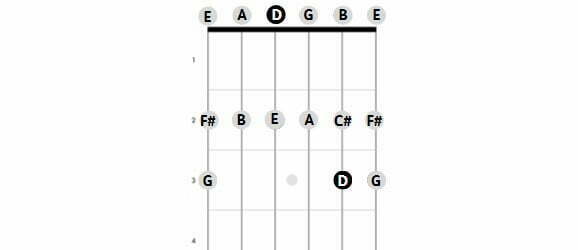How to play the D major scale on Guitar
Learning the D major scale is crucial for novice guitar players because it is widely used in various genres and popular songs, both old and new. It is one of the easiest major scales for beginners to learn and is an excellent starting point for anyone interested in playing covers or creating their own music. This lesson will guide you through the process of playing the D major scale, including the notes that comprise it and several different positions on your fretboard. Let's begin!
NOTES ON THE D MAJOR SCALE
The D major scale consits of 7 notes:
- D
- E
- F#
- G
- A
- B
- C#
The D major scale consists of the same notes as the B minor scale, but arranged differently. This similarity establishes B minor as the relative minor of D major. After becoming familiar with the notes that constitute the D major scale, we can explore various positions and finger placements on the fretboard for playing this scale.
D MAJOR SCALE POSITIONS
Guitar scale diagrams are an easy way to learn the D major scale. These diagrams depict the fretboard of your guitar, and each dot on the diagram represents a note you should play on a particular fret and string. If a dot has a note above the string, you should play the string in an open position. The dark dots on the diagram indicate the root note of the scale, which is D in this case.
Open position
Multiple techniques exist for playing the D major scale. However, in this tutorial, we will concentrate on two of the most prevalent methods. We will teach you how to play the D major scale in both the open position and the 6th position. To play the D major scale in the open position, use your index finger for notes on the second fret, your middle finger for notes on the third fret, and your ring finger for notes on the fourth fret.

6th position
To play the D major scale in the sixth position, begin with your index finger on the seventh fret, followed by your middle finger on the eighth fret, your ring finger on the ninth fret, and your pinky on the tenth fret. This variation of the D major scale includes a C# note on the 6th fret of your G string. To play it, move your index finger up one fret to play the C# before returning to the 7th fret to play a D note.

D MAJOR SCALE TABS
Guitar tabs are an alternative method for learning scales, distinct from guitar scale diagrams. Beginners may find guitar tabs to be a more straightforward and visual way of understanding scales. Guitar scale diagrams can be thought of as maps, while tabs are more like step-by-step instructions. It's crucial to learn both techniques for playing scales to become a more versatile guitar player. In the following section, we will examine guitar tabs for each of the scales covered in the preceding charts.
Open position tabs
To play the D major scale in open position, begin by playing an open note on your D string, and refer to this tab for guidance
6th position tabs
This is how you can play the D Major scale in the 6th position, utilizing tablature. Begin by placing your pinky finger on the tenth fret of the E string.
D MAJOR SCALE EXERCISES
Repetition is key to perfecting your guitar playing skills. As you learn to play the guitar, it's best to practice your scales repeatedly to ensure that you're accurately fretting each note with the correct finger placement. With time, your fingers will adapt and strengthen, allowing you to transition between notes and chords more quickly and smoothly. To stay on time, you may want to use a metronome as you practice your scales.
It's also a good idea to play the D major scale in various positions, beginning with the open position and then moving on to the 6th or other positions that you want to learn. As you play each scale, listen for the tonal differences in pitch as you play the same notes on different spots up and down the fretboard.
Scales can also be useful for improving your picking hand technique. You can use your scale practice to work on your alternate picking technique. By making scale practice a regular part of your guitar education, you'll be able to rock out in no time!








